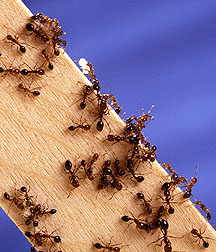| 
Widely disliked for their venomous, painful
stings, fire ants have spread across much of the southern United States.
Click the image for more information about it.
|
First Virus to Infect Red Imported Fire Ants
Discovered
By Jim Core
November 30, 2004 The first known virus to infect the
destructive and costly red imported fire ant (RIFA) was recently discovered by
Agricultural Research Service
scientists.
RIFA, Solenopsis invicta, currently infests about 300 million acres
in the United States. Although RIFA is native to South America, it thrives here
because of a lack of natural enemies. Fire ants cost Americans hundreds of
millions of dollars annually. The ants occasionally kill young, unprotected
livestock and wildlife, and they inflict a painful sting that is sometimes
deadly to humans.
Steven M.
Valles, an entomologist with the ARS Center for Medical, Agricultural and
Veterinary Entomology (CMAVE)
in Gainesville, Fla., and colleagues at CMAVE and the ARS
Horticulture
and Breeding Research Laboratory in Fort Pierce, Fla., have identified a
new natural enemy of RIFA.
The newly found natural agent is a virus in the Dicistroviridae family,
which is related to the well-known picorna-like viruses. The entire genome has
been sequenced, and studies suggest the virus, tentatively named Solenopsis
invicta virus-1 (SINV-1), may be an excellent biological control agent for
fire ants. Scientists use natural organisms as part of a strategy to reduce
RIFA numbers without using pesticides.
A survey in Florida locations found that approximately 23 percent of RIFA
nests examined were infected with SINV-1. The virus infects all fire ant castes
and stages of development, and Valles was able to successfully transmit the
viral infection to uninfected fire ant nests.
Brood in infected colonies died within three months during laboratory
studies, but the effect of the virus on field populations is still being
evaluated, according to Valles, who is in CMAVE's
Imported Fire
Ant and Household Insects Research Unit.
ARS researchers are currently examining SINV-1 to determine its
effectiveness and potential for use as a sustainable, microbial control agent
against the red imported fire ant.
ARS is the U.S. Department of
Agriculture's chief scientific research agency.